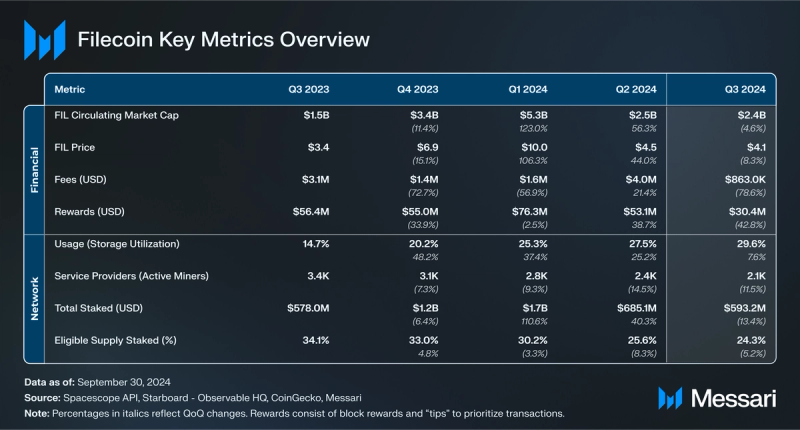Key Insights
- In Q3’24, Filecoin’s new storage deals increased by 16% QoQ. Storage utilization grew from 26% in Q2’24 to nearly 30% in Q3’24, while storage capacity fell 18% QoQ.
- Simultaneously, over 2,000 clients onboarded data on Filecoin by the end of Q3’24. Of those clients, 518 onboarded large datasets over 1,000 TiB.
- As of Sept. 30, 2024, over 4,500 unique contracts were deployed on the Filecoin Virtual Machine (FVM). DeFi net deposits on the FVM accounted for over 20 million FIL ($84 million) in Q3’24, primarily used in staking, liquid staking, and DEXs.
- Filecoin continues to develop as a decentralized physical infrastructure network (DePIN), creating a decentralized storage marketplace for enterprise adoption, as well as enabling decentralized compute and AI.
- In Q3’24, the ecosystem expanded through the announcement of the Filecoin Web Services (FWS) framework, offering a market for verifiable services for developers and users. Filecoin formed a series of AI partnerships to expand its data solutions.
Primer
Filecoin is building a marketplace for data services — with the first service being storage — on top of the InterPlanetary File System (IPFS). FIlecoin uses deals that price the storage based on a market of providers instead of fixed pricing. A storage deal is like a contract with a service level agreement (SLA) — users pay fees to providers to store data for a specified duration.
To keep data safe, Filecoin uses a cryptoeconomic incentive model to regularly verify the storage with zero-knowledge proofs. To incentivize storage providers to participate in deals, Filecoin rewards them with FIL, the network’s native token. Storage providers are slashed if they fail to provide reliable uptime or act maliciously against the network.
To retrieve data, Filecoin users pay a retrieval provider to fetch data. Unlike storage deals, which involve transactions onchain, retrieval deals use payment channels to settle payments offchain, to enable faster retrieval. Besides storage and retrieval, Filecoin aims to offer an open market where compute power can be contracted to run over data, providing more efficient alternatives to traditional centralized systems.
Key protocol upgrades to enable compute-over-data services include smart contracts (the Filecoin Virtual Machine – FVM) and scaling (Interplanetary Consensus – IPC). The launch of the FVM in March 2023 brought Ethereum-style smart contracts to enable new use cases on Filecoin, including token leasing, perpetual storage, and compute. Besides growing its FVM ecosystem, Filecoin focuses on enterprise adoption.
Website / X (Twitter) / Discord / Slack
Key Metrics
Performance Analysis
The Filecoin Network is primarily used to store data decentrally by two parties:
- The demand side, i.e., storage users in need of data storage
- The supply side, i.e., storage providers with excess storage capacity.
Network
The amount of data stored in active deals between storage users and providers gauges the demand for Filecoin storage.
Deals
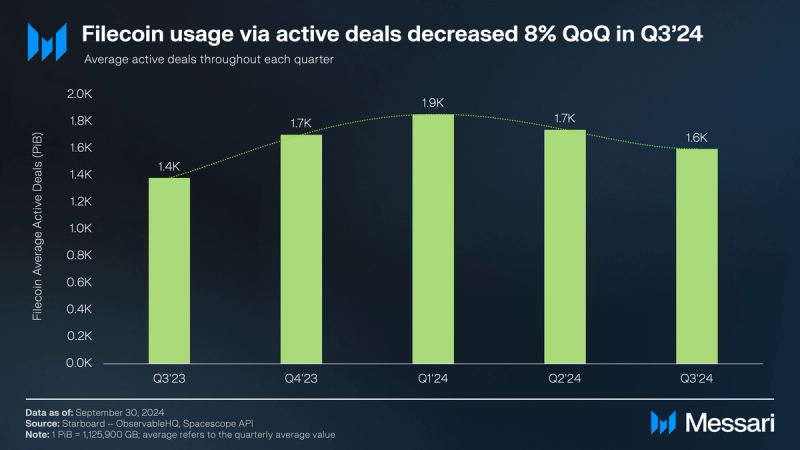
In Q3’24, over 1,600 PiB was stored on the Filecoin Network through active deals, down 8% QoQ. Filecoin’s current focus is on increasing enterprise adoption, with new use cases around data services, including perpetual archiving, data privacy, and integration with Web2 and Web3 applications.
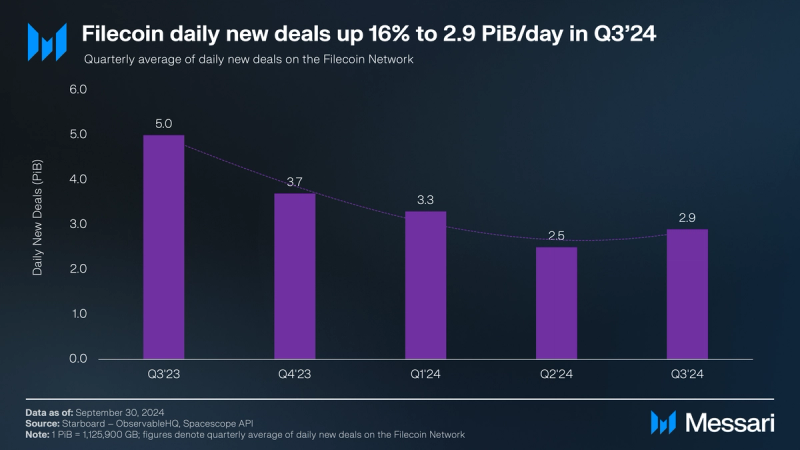
In Q3’24, daily new deals on the Filecoin Network increased by 16% QoQ to 2.9 PiB/day. The growth of the new deals is currently outpaced by expiring deals, given that active deals decreased 8% QoQ. New deals are contributing to an increase in the utilization of the Filecoin Network relative to its decreasing storage capacity.
Utilization vs. Capacity
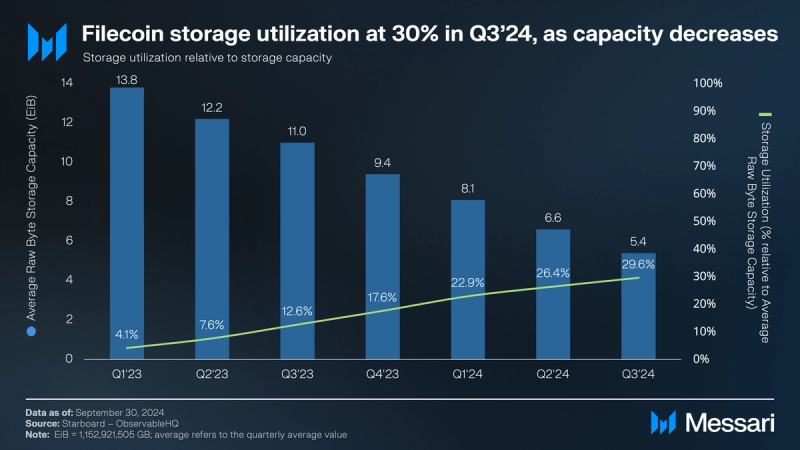
Filecoin’s storage utilization relative to the total available capacity increased to nearly 30% in Q3’24, up from 26% in Q2’24. While this increase is a net positive for Filecoin’s adoption through active storage deals, it requires the context of the network’s capacity.
In Q3’24, Filecoin experienced an 18% QoQ decline in average raw byte storage capacity to 5.4 EiB. The decline in storage capacity started two years ago, after reaching its all-time high at nearly 17 EiB in Q3’22. Notably, the focus of the network has shifted from incentivizing the supply of storage capacity to generating and onboarding demand.
The gradual decrease in average raw byte storage capacity was further reflected by the drop in the number of storage providers, which declined to approximately 2,100 in Q3’24 after reaching an all-time high of over 4,100 in Q3’22.
Clients
As per Messari’s guide on decentralized storage networks, Filecoin is geared toward providing cold storage solutions (e.g., archival and recovery) for enterprises and developers. Low storage prices help attract traditional businesses seeking cost-effective alternatives for storing large amounts of archival data.
The DeStor data storage provider on Filecoin partnered with Qamcom DDS to enhance the security, robustness, and scaling of its storage services. The partnership includes data clients like YayPal, a Web3 gaming studio with over 500,000 users, and Fieldstream, an AI marketing analytics platform. Examples of other client solutions include:
- GhostDrive: focused on prioritizing privacy and security through encryption, decentralization, and novel storage optimization techniques;
- Seal: focused on storage onramps for large clients such as UC Berkeley, Starling Labs, the Atlas Experiment, and the Casper Network;
- Steeldome: focused on data archival, backup, and recovery for enterprises.
Beyond cold storage, other efforts are driven by storage solutions from Lighthouse, RIBS, Retriev, and Flamenco, among others.
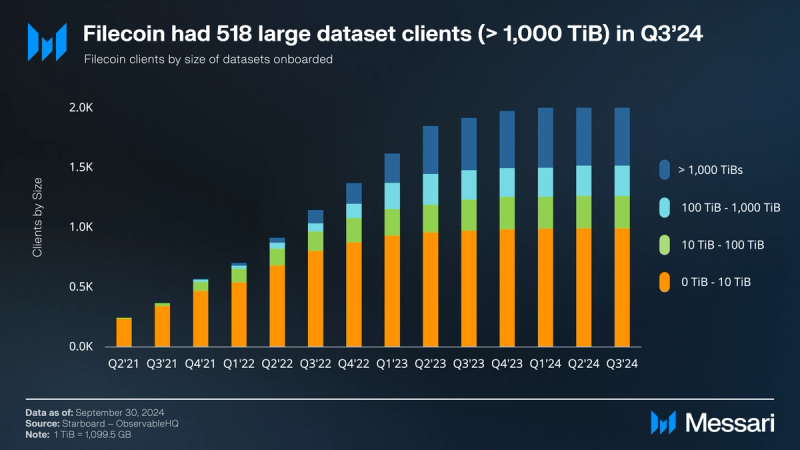
As of the end of Q3’24, 2,034 clients onboarded datasets on Filecoin. Of those clients, 518 onboarded large datasets (i.e., datasets that exceed 1,000 TiB in storage size). Several storage services are being offered to encourage usage via active deals, including CID Gravity, Titan Storage, and Decentrally. According to Filecoin’s client explorer, large clients range from The Starling Lab, to the NFT platform OpenSea, to Layer-1 network Solana. Notable efforts leveraging Filecoin include:
- The Victor Chang Cardiac Research Institute safeguarding and sharing research data.
- Democracy’s Library storing datasets collected by the Internet Archive at the end of each American presidential administration.
- SETI Institute using Filecoin to store astronomical research data.
- UC Berkeley collaborating with Seal Storage for storing physics research.
- GenRAIT to store critical genomics data on Filecoin.
- Research center Starling Lab storing sensitive digital records of human history.
- Ewesion (China’s fastest growing host of graphic files) using Filecoin for data preservation.
- DeSci Labs using decentralized data storage on Filecoin to enable research to be reproduced and independently verified by other researchers.
- Opscientia (OpSci) leveraging Filecoin to make it easier for scientists around the world to share data.
- Destor and Seal Storage collaborate on an AI data integrity improvement research project with Cyber SMART, an industry-university cooperative funded by the National Science Foundation and industry members.
An overview of featured clients leveraging the Filecoin Network can be accessed here.
Retrievals
To meet the needs of hot storage use cases, a growing number of Layer-2s and protocols are being built atop Filecoin and IPFS. Examples include:
- Basin: focused on decentralized AI/ML and DePIN.
- Akave: enabling onchain data lakes for decentralized AI.
- Storacha: focusing on gaming and small hot storage use cases (e.g. IPFS content).
Project Saturn, which completed its closed beta as a content delivery network (CDN) for Filecoin and IPFS, has integrated with Web3.Storage and will be building out their hot storage layer as the Storacha network. The goal of this integration is to build a combined product and network for fast storage and retrieval. Simultaneously, tools such as the Station app bring decentralized retrievals to desktops, with the SPARK and Voyager modules allowing retrieval checks on the network. For context, Station uses idle compute resources and offers FIL rewards.
FVM Traction
When the Filecoin Virtual Machine (FVM) launched in March 2023, it brought Ethereum-style smart contracts to Filecoin. As of September 30, 2024, over 4,500 unique contracts are deployed on the FVM, facilitating nearly 3 million transactions.
Token staking and leasing activity is expected to continue to grow, as GLIF, the DeFi protocol driving a large chunk of FVM activity, has introduced a new way for users to engage and earn GLIF points, called quests. These quests, ranging from social media interactions to partner project collaborations, aim to foster community-driven activities such as the first quest on Galxe or partner quests. As of the time of the writing, over 82 million GLIF points that have been distributed to GLIF users will convert 1-to-1 with GLIF tokens in Q4.
Decentralized lending is a further area of growth for the FVM. The FILLiquid lending platform allows FIL tokenholders to earn interest on their deposits and enables storage providers (SPs) to secure loans. After reaching over 20,000 unique wallets during its testnet phase, the platform has launched FIG Staking, a new product that allows users to earn yield by staking the platform’s governance token, FIG.
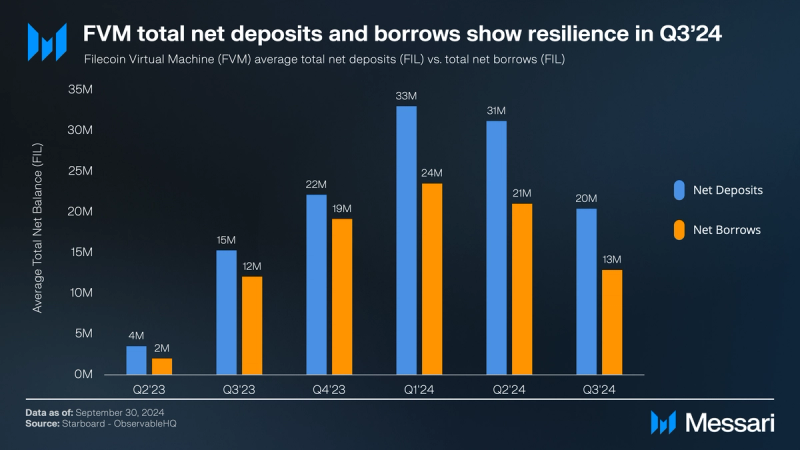
According to the FVM Explorer, average DeFi net deposits on the FVM accounted for over 20 million FIL in Q3’24 (approx. $84 million), primarily used in staking, liquid staking, and DEXs. The liquid staking protocol GLIF accounted for the majority of deposits (62% as of the end of Q3’24), followed by FilFi (10%), SFT Protocol (10%), and others (18%).
Simultaneously, average DeFi net borrows accounted for 13 million FIL (approx. $53 million) in Q3’24, according to the FVM DeFi leaderboard. Both deposits and borrows showed resilience in Q3’24, primarily driven by the overall risk-off market environment.
Financials
Filecoin’s revenue framework is similar to Ethereum’s because its gas system is based on EIP-1559. This gas system consists of network fees that are burned to compensate for the resources used. Both storage users and storage providers generate revenue.
Fees
As per Messari’s revenue analysis, Filecoin’s fees comprise of:
- Base fees – Determined by blockspace congestion and required by any storage proof.
- Batch fees – Used for bundling storage proofs.
- Overestimation fees – Required to optimize gas usage.
- Penalty fees – Collected for storage provider failures.

Base fees on Filecoin increased 11x QoQ to nearly $110,000 Q3’24. Simultaneously, penalty fees decreased 85% QoQ to $600,000, reaching its lowest value over the past five quarters. This development indicates increased reliability in storage provider services.
Rewards
Filecoin’s rewards to storage providers consist of:
- Block rewards disbursed by the network.
- “Tips” to prioritize transactions for block inclusion.
Block rewards accounted for more than 99.9% of all rewards in Q3’24, while “tips” accounted for only a small portion. The minting mechanism of new FIL tokens relies on both:
- An exponential decay model (30% of tokens): Block rewards are highest initially to stimulate participation and then decrease exponentially over time.
- A baseline model (70% of tokens): Block rewards are allocated as storage capacity grows.
By combining these models, Filecoin can maintain participation after block reward distribution in the early stages of the network (see exponential decay model). It also helps continuously reward additional value created for the network through increased storage capacity (see baseline model).
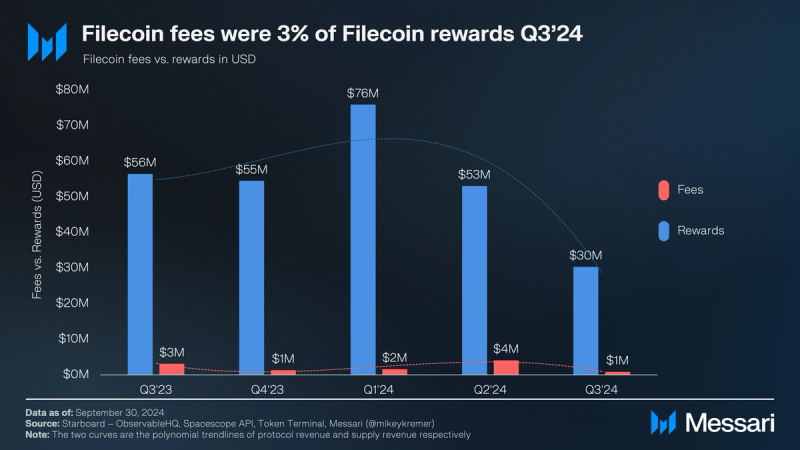
Rewards decreased 43% from $53 million in Q2’24 to $30 million in Q3’24, driven by the FIL/USD price decrease and a 13% reduction of rewards in FIL. Specifically FIL reward issuance decreased from 9.0 million FIL in Q2’24 to 7.8 million FIL in Q3’24. The decrease in FIL reward issuance will likely continue in the coming quarters. For an in-depth discussion and simulations of future FIL issuance, please refer to Messari’s investigation on the FIL circulating supply.
Ecosystem Overview
As of September 2024, nearly 180 known projects are included in the Filecoin Ecosystem Explorer, a non-exhaustive community-powered database of projects in the network. While activity on the Filecoin ecosystem has been historically dominated by data storage, its ecosystem expansion and AI integration efforts in Q3’24 aim to provide infrastructure for applications in areas including decentralized AI, data management and analytics, gaming, and communication.
Data Management and Analytics
Projects like Lighthouse and Destra leverage Filecoin to offer perpetual data storage with a one-time payment. Triton One completed the initial phases of the Old Faithful project to make Solana’s ledger history available to the community. Seal Storage provides immutable data solutions, catering to businesses and individuals seeking secure, long-term storage. Cryptosat uses mini-satellites for secure verifiability, aiming to enhance space-based data collection and verification.
When it comes to distributed compute, Basin powers platforms like Tableland and WeatherXM with data-intensive analytics and operations. Akave enables the creation of onchain data lakes. Further projects on Filecoin that offer data services include:
- Fluence: Empowers developers to scale their Web3 projects.
- Storacha: Decentralized hot storage network, with a focus on DePIN Gaming.
- Ramo Network: Monetization of idle compute capacity.
- Bagel: GPU Restaking and Artificial Intelligence Infrastructure.
- IoTeX, an open modular infrastructure for DePINs.
Artificial Intelligence and Machine Learning
A key development in Filecoin’s integration with AI and machine learning applications has been the collaboration with SingularityNET. This collaboration focuses on securing metadata via Lighthouse, aiming to ensure verifiable model training and promote ethical AI practices.
Another significant development is the collaboration with Theoriq AI to develop AI agents for analyzing declassified CIA datasets. This project aims to enable efficient research of over one million documents, combining AI with decentralized storage for complex data analysis. An outcome of this partnership is the Filecoin AI-agent, trained on Filecoin’s documentation and GitHub repositories.
Simultaneously, Filecoin integrated with Eternal AI’s model storage, EQTY Lab uses IPFS and Filecoin to validate AI model lineage, Bagel Network provides a GPU marketplace and AI infrastructure, Aethir and Ramo Network monetize idle compute capacity, while Nuklai Data offers a collaborative ecosystem for private data networks.
Consumer
The gaming industry is also tapping into Filecoin’s capabilities. OP Games facilitates NFT minting for games, Fluence empowers developers to scale Web3 projects, while the Storacha Network focuses on decentralized hot storage for DePIN gaming. File Market creates Web3 shops and marketplaces.
Decentralized Communication
Huddle01 provides decentralized video conferencing solutions leveraging Filecoin’s infrastructure, addressing the demand for secure and private communication platforms.
Qualitative Analysis
Key Developments
Key technological advancements made in Q3’24 include protocol upgrades, new services, and software improvements. These advancements enhance Filecoin’s capabilities in decentralized storage and computing.
Filecoin “Waffle” Upgrade
The Filecoin “Waffle” upgrade was released on Aug. 6, 2024, introducing improvements to the network’s efficiency, security, and core infrastructure. The Waffle upgrade incorporated six Filecoin Improvement Proposals (FIPs), addressing specific aspects of the network’s functionality. Notably:
- FIP-0065 simplifies the network’s circulating supply calculation by excluding the locked balances of the built-in market actor, preparing for direct data commitments without requiring market deals
- FIP-0079 implemented BLS aggregate signatures in the FVM, which may improve verification efficiency for smart contract interactions.
- FIP-0092 introduced the Non-Interactive PoRep (NI-PoRep) protocol as part of the Waffle upgrade, representing a change in Filecoin’s proof systems, which may reduce barriers to entry for new storage providers and improve the network’s efficiency.
Filecoin Fast Finality (F3)
Following the Waffle upgrade, Filecoin announced the Filecoin Fast Finality (F3) upgrade, aiming to reduce transaction finalization times to under one minute, addressing a limitation in Filecoin’s previous consensus mechanism. F3 is being implemented in two phases:
- The first phase introduces the Easy Finality Calculator, aims to reduce finalization time to about 15 minutes using existing data without protocol changes.
- In the second phase, F3 aims to provide finality in under one minute with verifiable certificates.
F3 integrates a new consensus protocol designed to accelerate the finality period. This hybrid approach merges finality gadgets with BFT protocols, aiming to improve speed, security, and resilience against various types of attacks.
For developers, F3 could enable the creation of more responsive applications. Exchanges may benefit from faster transaction confirmations, potentially enhancing trading efficiency. Bridge builders may benefit from trustless and low-cost operations.
Introduction of Filecoin Web Services (FWS)
Filecoin announced Filecoin Web Services (FWS) at FIL Brussels 2024, expanding its offerings beyond decentralized storage. FWS aims to create a composable framework for protocols building on the decentralized cloud.
This aims to simplify services like unified billing and encourage reuse of components for storage primitives. These features are intended to lower entry barriers for developers, boost network revenue, and improve overall network functionality. For developers, it may provide easier access to a suite of decentralized services, potentially enabling the creation of more sophisticated decentralized applications. For users, it could translate to a more seamless experience when interacting with Filecoin-based services.
Lotus Software Updates
Throughout Q3’24, the Lotus software, an implementation of the Filecoin network, underwent several updates, focusing on enhancing network functionality, improving Ethereum compatibility, and addressing performance and security issues. Key updates included:
- Lotus V1.27.2 (Jul. 17, 2024) introduced improvements for RPC methods and upgraded libp2p to V0.35.3.
- Lotus V1.28.1 (Jul. 25, 2024) implemented the Filecoin “Waffle” upgrade, including support for legacy Ethereum transactions (FIP-0091).
- Lotus V1.28.2 (Aug. 15, 2024) fixed critical issues causing excessive bandwidth usage and included F3 performance improvements.
- Lotus V1.29.0 (Sep. 2, 2024) enhanced Ethereum RPC functionality.
These updates collectively represent changes in Filecoin’s technical capabilities, enhancing its interoperability with Ethereum-based tools. On Sep. 16, the Filecoin network reported a partial network outage involving many Filecoin nodes not being able to sync due to “failure to verify beacon.” Following this event, Lotus patches V1.28.3 and v1.29.1 have been released and the impacted nodes are recovered, while Filecoin will continue to monitor the network.
Key Events
Inclusion in Grayscale’s Decentralized AI Fund
Filecoin’s institutional recognition expanded with the launch of Grayscale’s Decentralized AI Fund on Jul. 17, 2024. This fund, targeting accredited investors, includes Filecoin (FIL) as one of its components, alongside other prominent projects in the decentralized AI space. As of the time of the writing, FIL comprises 17% of the fund’s composition.
For context, Grayscale Investments’ launch of its Decentralized AI Fund targets accredited investors and focuses on AI-centric cryptocurrencies and blockchain projects. This fund represents market recognition of Filecoin’s role in decentralized AI infrastructure.
Developer Summits and Events
The Filecoin Dev Summit 2024 took place in Brussels in July. The event explored the evolution of the Filecoin protocol beyond its core data storage capabilities, indicating potential expansion in the network’s functionalities. Key focus areas included:
- The Filecoin Protocol Evolution track examined the latest advancements, upcoming features, and the network’s long-term vision.
- Security-dedicated sessions aimed at enhancing the network’s resilience.
Key Governance
Filecoin’s governance model continued to evolve in Q3’24, with several developments aimed at enhancing decentralization and community participation in decision-making processes.
Community Roadmapping
The Community Roadmapping session held during the Filecoin Dev Summit 2024 brought together participants from diverse backgrounds to collaborate on updating the collective community roadmap. Community input has been collected to be included in future roadmap developments for Filecoin.
Fil+ Program Evolution
The Fil+ program continues to evolve, with more than 50 active allocators working on DataCap renewal pathways. This development showcases Filecoin’s efforts to refine its governance structures, particularly in managing and allocating network resources.
Closing Summary
In Q3’24, Filecoin’s new storage deals increased by 16% QoQ. Storage utilization grew from 26% in Q2’24 to nearly 30% in Q3’24, while storage capacity fell 18% QoQ. Simultaneously, over 2,000 clients onboarded data on Filecoin by the end of Q3’24. Of those clients, 518 onboarded large datasets over 1,000 TiB. As of Sept. 30, 2024, over 4,500 unique contracts were deployed on the Filecoin Virtual Machine (FVM). DeFi net deposits on the FVM accounted for over 20 million FIL ($84 million) in Q3’24, primarily used in staking, liquid staking, and DEXs.
Filecoin continues to develop as a decentralized physical infrastructure network (DePIN), creating a decentralized storage marketplace for enterprise adoption, as well as enabling decentralized compute and AI. In Q3’24, the ecosystem expanded through the announcement of the Filecoin Web Services (FWS) framework, offering a market for verifiable services for developers and users. Filecoin formed a series of AI partnerships to expand its data solutions. Additionally, Filecoin implemented the “Waffle” upgrade and announced Filecoin Fast Finality (F3), addressing scalability and efficiency challenges.

